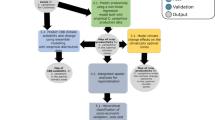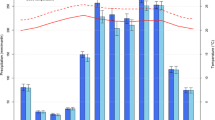Abstract
This research explores interactions between farmers’ knowledge and socioeconomic circumstances and the floristic composition of multistrata coffee plantations in Chiapas, Mexico. Interviews with 24 individual farmers with accompanying vegetation transects and two community level participatory workshops were carried out. The frequency, density, dominance, utility and importance value for all tree species surveyed were obtained. Farmers were grouped by cluster analysis on the basis of their land area, time producing coffee and the age of their coffee farms but the dominant shade species in their coffee plantations was not influenced by socioeconomic status (p<0.05). A total of 74 shade species were recorded and classified as temporary, suitable, or unsuitable as shade species by farmers, based on attributes such as leaf phenology, foliage density, crown shape and the amount and timing of litter decomposition, as well as their overall impact on coffee yield. Principal component and cluster analysis using these attributes confirmed the consistency of the farmers’ classification system. A group of preferred species was identified, but less than half the trees recorded on farms were of these species, showing that farmers retained a wide range of trees and shrubs in their plantations, taking into account not only commercial interests but also their contribution to ecosystem functions. Farmers harnessed the forces of secondary succession by retaining pioneers as temporary shade, knowing that they would naturally be succeeded, while at the same time promoting and tolerating other longer living native species that they considered more suitable as coffee shade. Managing diverse secondary succession instead of establishing monospecific shade was an efficient way for farmers to achieve acceptable coffee yields while contributing to biodiversity and landscape conservation that could allow them access to niche markets.
Similar content being viewed by others
References
Altieri M.A. and Merrick L.C. (1987). In situ conservation of crop genetic resources through maintenance of traditional farming systems. Econ. Bot. 41(1): 86–96
Beer J., Muschler R., Kass D. and Somarriba E. (1998). Shade management in coffee and cacao plantations. Agrofor. Syst. 38: 139–164
Castillo A. and Toledo V.M. (2000). Applying ecology in the third world. The case of México. BioScience 50(1): 1–5
CEPAL. (1982). Economía campesina y agricultura empresarial: tipología de productores del agro Mexicano. Siglo Veintiuno Editores, Mexico, 339
Crowley E.L. and Carter S.E. (2000). Agrarian change and the changing relationships between toil and soil in MaragoliWestern Kenya (1900–1994). Human Ecol. 28(3): 383–414
Montoya-Gomez G., Nelson K., Soto-Pinto L., Taylor J., Tipper R. and Jong B.H. (1995). Community forest management and carbon sequestration: a feasibility study from Chiapas, Mexico. Interciencia 20(6): 409–416
Donald P.F. (2004). Biodiversity impacts of some agricultural commodity production systems. Conserv. Biol. 18(1): 17–37
Escamilla P.E., Licona-Vargas A., Díaz-Cárdenas S., Santoyo-Cortéz H. and Rodríguez-Ramírez L. (1994). Los sistemas de producción de café en el centro de Veracruz, México. Un análisis tecnológico. Revista de Historia (Centro de Investigaciones Históricas, Universidad de Costa Rica) 30: 41–67
Finegan B. (1996). Pattern and process in neotropical secondary rain forests: the first 100 years of succession. Trends Ecol. Evol. 11(3): 119–124
GEA. (1993). El proceso de evaluación Rural Participativa. Una propuesta metodológica. Instituto de los Recursos Mundiales (WRI), Grupo de Estudios Ambientales (GEA) AC, México, DF
Giovannucci D. (2001). Sustainable Coffee Survey of the North American Specialty Coffee Industry. The Summit Foundation, Nature Conservancy, NACEC & The World Bank, USA, 32
Gobbi J.A. (2000). Is biodiversity-friendly coffee financially viable? An analysis of five different coffee production systems in western El Salvador. Ecol. Econ. 33: 267–281
Godinez M.J. 1997. Caracterización del sistema agroforestal café orgánico bajo sombra en tres municipios de la Región Fronteriza del estado de Chiapas. MsC. Thesis Universidad de Chapingo, Mexico.
Grossman J.M. (2003). Exploring farmer knowledge of soil processes in organic coffee systems of Chiapas, Mexico. Geoderma 111: 267–387
ICRAF 1983. Resources for agroforestry diagnosis and design: a handbook of useful tools and materials. Working paper No 7. ICRAF, Nairobi, Kenya.
INEGI. (2000). Anuario Estadístico del Estado de Chiapas. Gobierno del Estado de Chiapas, Mexico
Joshi L., Shrestha P.K., Moss C. and Sinclair F.L. (2004). Locally derived knowledge of soil fertility and its emerging role in integrated natural resource management. In: Cadisch, G. and Ong, C. (eds) Below-ground Interactions Tropical Agroecosystems: Concepts and Models with Multiple Plant Components, pp 17–39. CAB International, Wallingford
Lyngbæk A.E., Muschler R.G. and Sinclair F.L. (2001). Productivity and profitability of multistrata organic versus conventional coffee farms in Costa Rica. Agrofor. Syst. 53: 205–213
McCune B. and Mefford M.J. (1999). PC-ORD Multivariate Analysis of Ecological Data. Vers. 4. MjM Software Design, Gleneden Beach, Oregon, USA
Mendoça E.S and Stott D.E. (2003). Characteristics and decomposition rates of pruning residues from a shaded coffee system in Southestern Brazil. Agrofor. Syst. 57: 117–125
Moguel P. and Toledo V.M. (1999). Biodiversity conservation in traditional coffee systems of México. Conserv. Biol. 13(1): 9–25
Morales H. and Perfecto I. (2000). Traditional knowledge and pest management in the Guatemalan Highlands. Agricult. Human Values 17(1): 49–63
Mueller-Dumbois E. and Ellenberg H. (1974). Aims and Methods of Vegetation Ecology. John Wiley, New York
Muschler R.G. (2001). Shade improves coffee quality in a sub-optimal coffee-zone of Costa Rica. Agrofor. Syst. 85: 131–139
Peeters L.Y.K., Soto-Pinto L., Perales H., Montoya G. and Ishiki M. (2003). Coffee production, timber and firewood in Southern México. Agriculture Ecosyst. Environ. 95(2–3): 481–493
Perfecto I., Rice R. and Greenberg M. (1996). Shade coffee: a disappearing refuge for biodiversity. BioScience 46(8): 598–608
Ramirez-Marcial N., Gonzalez-Espinosa M. and Williams-Linera G. (2001). Anthropogenic disturbance and tree diversity in Montane Rain Forest in Chiapas, Mexico. Forest Ecol. Manage. 154: 311–326
Ramírez-Marcial N. 2002. Disturbio humano y la diversidad de árboles y arbustos del bosque mesofilo en las montañas del norte de Chiapas. PhD Thesis. Instituto de Ecologia, Xalapa, Mexico.
Romero-Alvarado Y. 2000. Efecto del tipo de sombra del cafetal sobre los rendimientos, nutrientes del suelo y la temperatura en Chiapas, Mexico. MSc. Thesis El Colegio de la Frontera Sur, Mexico.
SAS Institute Inc. (1990). SAS/STAT. User’s Guide. Version 6. SAS Institute Inc., Cary, North Carolina, USA
Sinclair F.L. and Walker D.H. (1999). A utilitarian approach to the incorporation of local knowledge in agroforestry research and extension. In: Buck, L.E., Lassoie, J.P. and Fernandes, E.C.M. (eds) Agroforestry in Sustainable Agricultural Systems, pp 245–275. CRC Press LLC, USA
Soto-Pinto L., Perfecto I., Castillo H.J. and Caballero N.J. (2000). Shade effect on coffee production at the northern Tzeltal zone of state of Chiapas, México. Agricult. Ecosyst. Environ. 80: 61–69
Soto-Pinto L., Perfecto I. and Caballero-Nieto J. (2002). Shade over coffee: its effects on berry borerleaf rust and spontaneous herbs in Chiapas, Mexico. Agrofor. Syst. 5: 37–45
Staver C., Guharay F., Monterroso D. and Muschler R.G. (2001). Designing pest-suppressive multistrata perennial crop systems: shade-grown coffee in Central America. Agrofor. Syst. 53: 151–170
Steel D.R., Torrie J.H. and Dickey D. (1997). Principles and Procedures of Statistics: A Biometrical Approach. McGraw-Hill, Inc., USA
Straede S., Nebel G. and Rijal A. (2002). Structure and floristic composition of community forests and their compatibility with villagers’ traditional needs for forest products. Biodivers. Conserv. 11: 487–508
Thapa B., Walker D.H. and Sinclair F.L. (1997). Indigenous knowledge of the feeding value of tree fodder. Animal Feed Sci. Technol. 67: 97–114
Thapa B., Sinclair F.L. and Walker D.H. (1995). Incorporation of indigenous knowledge and perspectives in agroforestry development. Part Two: case-study on the impact of explicit representation of farmers’ knowledge. Agrofor. Syst. 30: 249–261
Walker D.H. and Sinclair F.L. (1998). Acquiring qualitative knowledge about complex agroecosystems. Part 2: formal representation. Agroforest Syst 56(3): 365–386
Walker D.H., Sinclair F.L., Joshi L. and Ambrose B. (1997). Prospects for the use of corporate knowledge bases in the generation, management and communication of knowledge at a frontline agricultural research centre. Agricult. Syst. 54(3): 291–312
Ward J. 2001. Farmer’s knowledge about organic coffee production from a Costa Rican producers association. M.Sc. thesis, University of Wales, Bangor.
Wringley G. 1988. Coffee. Longman, New York, USA.
Author information
Authors and Affiliations
Corresponding author
Rights and permissions
About this article
Cite this article
Soto-Pinto, L., Villalvazo-López, V., Jiménez-Ferrer, G. et al. The role of local knowledge in determining shade composition of multistrata coffee systems in Chiapas, Mexico. Biodivers Conserv 16, 419–436 (2007). https://doi.org/10.1007/s10531-005-5436-3
Received:
Accepted:
Published:
Issue Date:
DOI: https://doi.org/10.1007/s10531-005-5436-3




